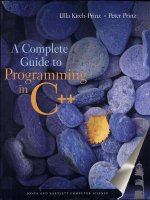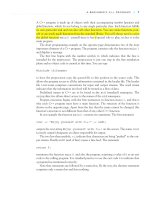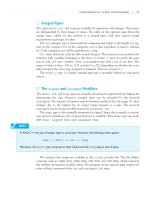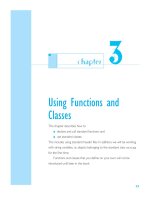A Complete Guide to Programming in C++ part 9 pdf
Bạn đang xem bản rút gọn của tài liệu. Xem và tải ngay bản đầy đủ của tài liệu tại đây (241.06 KB, 10 trang )
STREAMS
■
59
ᮀ I/O Stream Classes
During the development of C++ a new class-based input/output system was imple-
mented. This gave rise to the I/O stream classes, which are now available in a library of
their own, the so-called iostream library.
The diagram on the opposite page shows how a so-called class hierarchy develops due
to inheritance. The class ios is the base class of all other stream classes. It contains the
attributes and abilities common to all streams. Effectively, the ios class
■ manages the connection to the physical data stream that writes your program’s
data to a file or outputs the data on screen
■ contains the basic functions needed for formatting data. A number of flags that
determine how character input is interpreted have been defined for this purpose.
The istream and ostream classes derived from ios form a user-friendly interface
for stream manipulation. The istream class is used for reading streams and the
ostream class is used for writing to streams. The operator >> is defined in istream
and << is defined in ostream, for example.
The iostream class is derived by multiple inheritance from istream and ostream
and thus offers the functionality of both classes.
Further stream classes, a file management class, for example, are derived from the
classes mentioned above. This allows the developer to use the techniques described for
file manipulation. These classes, which also contain methods for opening and closing
files, will be discussed in a later chapter.
ᮀ Standard Streams
The streams cin and cout, which were mentioned earlier, are instances of the
istream or ostream classes. When a program is launched these objects are automati-
cally created to read standard input or write to standard output.
Standard input is normally the keyboard and standard output the screen. However,
standard input and output can be redirected to files. In this case, data is not read from
the keyboard but from a file, or data is not displayed on screen but written to a file.
The other two standard streams cerr and clog are used to display messages when
errors occur. Error messages are displayed on screen even if standard output has been
redirected to a file.
60
■
CHAPTER 4 INPUT AND OUTPUT WITH STREAMS
Here the manipulator showpos is called.
↓
cout << showpos << 123; // Output: +123
The above statement is equivalent to
cout.setf( ios::showpos);
cout << 123;
The other positive numbers are printed with their sign as well:
cout << 22; // Output: +22
The output of a positive sign can be canceled by the manipulator
noshowpos:
cout << noshowpos << 123; // Output: 123
The last statement is equivalent to
cout.unsetf( ios::showpos);
cout << 123;
■ The operators >> and << format the input and/or output according to how the flags in the base class
ios are set
■ The manipulator showpos is a function that calls the method cout.setf(ios::showpos);,
ios::showpos being the flag showpos belonging to the ios class
■ Using manipulators is easier than directly accessing flags. For this reason, manipulators are described in
the following section, whereas the methods
setf() and unsetf() are used only under exceptional
circumstances.
■ Old compilers only supply some of the manipulators. In this case, you have to use the methods setf()
and unsetf().
✓
HINTS
■
FORMATTING AND MANIPULATORS
Example: Calling a manipulator
FORMATTING AND MANIPULATORS
■
61
ᮀ Formatting
When reading keyboard input, a valid input format must be used to determine how input
is to be interpreted. Similarly, screen output adheres to set of rules governing how, for
example, floating-point numbers are displayed.
The stream classes istream and ostream offer various options for performing these
tasks. For example, you can display a table of numeric values in a simple way.
In previous chapters we have looked at the cin and cout streams in statements such
as:
cout << "Please enter a number: ";
cin >> x;
The following sections systematically describe the abilities of the stream classes. This
includes:
■ the >> and << operators for formatted input and output. These operators are
defined for expressions with fundamental types—that is, for characters, boolean
values, numbers and strings.
■ manipulators, which can be inserted into the input or output stream. Manipula-
tors can be used to generate formats for subsequent input/output. One manipula-
tor that you are already familiar with is endl, which generates a line feed at the
end of a line.
■ other methods for determining or modifying the state of a stream and unformat-
ted input and output.
ᮀ Flags and Manipulators
Formatting flags defined in the parent class ios determine how characters are input or
output. In general, flags are represented by individual bits within a special integral vari-
able. For example, depending on whether a bit is set or not, a positive number can be
output with or without a plus sign.
Each flag has a default setting. For example, integral numbers are output as decimals by
default, and positive numbers are output without a plus sign.
It is possible to modify individual formatting flags. The methods setf() and
unsetf() can be used for this purpose. However, the same effect can be achieved sim-
ply by using so-called manipulators, which are defined for all important flags. Manipula-
tors are functions that can be inserted into the input or output stream and thus be called.
62
■
CHAPTER 4 INPUT AND OUTPUT WITH STREAMS
// Reads integral decimal values and
// generates octal, decimal, and hexadecimal output.
#include <iostream> // Declarations of cin, cout and
using namespace std; // manipulators oct, hex,
int main()
{
int number;
cout << "Please enter an integer: ";
cin >> number;
cout << uppercase // for hex-digits
<< " octal \t decimal \t hexadecimal\n "
<< oct << number << " \t "
<< dec << number << " \t "
<< hex << number << endl;
return 0;
}
■
FORMATTED OUTPUT OF INTEGERS
Manipulators formatting integers
Sample program
Manipulator Effects
Octal base
Hexadecimal base
Decimal base (by default)
Generates a + sign in non-negative numeric
output.
Generates capital letters in hexadecimal
output.
Generates non-negative numeric output
without a + sign (by default).
Generates lowercase letters in hexadecimal
output (by default).
oct
hex
dec
showpos
noshowpos
uppercase
nouppercase
FORMATTED OUTPUT OF INTEGERS
■
63
ᮀ Formatting Options
The << operator can output values of type short, int, long or a corresponding
unsigned type. The following formatting options are available:
■ define the numeric system in which to display the number: decimal, octal, or
hexadecimal
■ use capitals instead of small letters for hexadecimals
■ display a sign for positive numbers.
In addition, the field width can be defined for the above types. The field width can
also be defined for characters, strings, and floating-point numbers, and will be discussed
in the following sections.
ᮀ Numeric System
Integral numbers are displayed as decimals by default. The manipulators oct, hex, and
dec can be used for switching from and to decimal display mode.
Example: cout << hex << 11; // Output: b
Hexadecimals are displayed in small letters by default, that is, using a, b, , f. The
manipulator uppercase allows you to use capitals.
Example: cout << hex << uppercase << 11; //Output: B
The manipulator nouppercase returns the output format to small letters.
ᮀ Negative Numbers
When negative numbers are output as decimals, the output will always include a sign.
You can use the showpos manipulator to output signed positive numbers.
Example: cout << dec << showpos << 11; //Output: +11
You can use noshowpos to revert to the original display mode.
When octal or hexadecimal numbers are output, the bits of the number to be output are
always interpreted as unsigned! In other words, the output shows the bit pattern of a
number in octal or hexadecimal format.
Example: cout << dec << -1 << " " << hex << -1;
This statement causes the following output on a 32-bit system:
-1 ffffffff
64
■
CHAPTER 4 INPUT AND OUTPUT WITH STREAMS
#include <iostream>
using namespace std;
int main()
{
double x = 12.0;
cout.precision(2); // Precision 2
cout << " By default: " << x << endl;
cout << " showpoint: " << showpoint << x << endl;
cout << " fixed: " << fixed << x << endl;
cout << " scientific: " << scientific << x << endl;
return 0;
}
The key word const within the prototype of precision() signifies that the method performs only
read operations.
✓
NOTE
■
FORMATTED OUTPUT OF FLOATING-POINT NUMBERS
Manipulators formatting floating-point numbers
Methods for precision
Sample program
Manipulator Effects
Sets the precision to n.
Returns the used precision.
int precision (int n);
int precision() const;
Manipulator Effects
Generates a decimal point character
shown in floating-point output. The
number of digits after the decimal point
corresponds to the used precision.
Output in fixed point notation
Output in scientific notation
Sets the precision to
n.
Trailing zeroes after the decimal point
are not printed.
If there are no digits after the decimal
point, the decimal point is not printed
(by default).
showpoint
noshowpoint
fixed
scientific
setprecision (int n)
FORMATTED OUTPUT OF FLOATING-POINT NUMBERS
■
65
ᮀ Standard Settings
Floating-points are displayed to six digits by default. Decimals are separated from the
integral part of the number by a decimal point. Trailing zeroes behind the decimal point
are not printed. If there are no digits after the decimal point, the decimal point is not
printed (by default).
Examples: cout << 1.0; // Output: 1
cout << 1.234; // Output: 1.234
cout << 1.234567; // Output: 1.23457
The last statement shows that the seventh digit is not simply truncated but rounded.
Very large and very small numbers are displayed in exponential notation.
Example: cout << 1234567.8; // Output: 1.23457e+06
ᮀ Formatting
The standard settings can be modified in several ways. You can
■ change the precision, i.e. the number of digits to be output
■ force output of the decimal point and trailing zeroes
■ stipulate the display mode (fixed point or exponential).
Both the manipulator setprecision()and the method precision() can be used to
redefine precision to be used.
Example: cout << setprecision(3); // Precision: 3
// or: cout.precision(3);
cout << 12.34; // Output: 12.3
Note that the header file iomanip must be included when using the manipulator set-
precision()
. This also applies to all standard manipulators called with at least one
argument.
The manipulator showpoint outputs the decimal point and trailing zeroes. The
number of digits being output (e.g. 6) equals the current precision.
Example: cout << showpoint << 1.0; // Output: 1.00000
However, fixed point output with a predetermined number of decimal places is often more
useful. In this case, you can use the fixed manipulator with the precision defining the
number of decimal places. The default value of 6 is assumed in the following example.
Example: cout << fixed << 66.0; // Output: 66.000000
In contrast, you can use the scientific manipulator to specify that floating-point
numbers are output as exponential expressions.
66
■
CHAPTER 4 INPUT AND OUTPUT WITH STREAMS
The manipulators setw() and setfill() are declared in the header file iomanip .
✓
NOTE
■
OUTPUT IN FIELDS
Element functions for output in fields
Manipulators for output in fields
Examples
#include <iostream> // Obligatory
#include <iomanip> // declarations
using namespace std;
1st Example: cout << '|' << setw(6) << 'X' << '|';
Output: | X| // Field width 6
2nd Example: cout << fixed << setprecision(2)
<< setw(10) << 123.4 << endl
<< "1234567890" << endl;
Output: 123.40 // Field width 10
1234567890
Method Effects
Returns the minimum field width used
Sets the minimum field width to n
Returns the fill character used
Sets the fill character to ch
int width() const;
int width(int n);
int fill() const;
int fill(int ch);
Manipulator Effects
Sets the minimum field width to n
Sets the fill character to ch
Left-aligns output in fields
Right-aligns output in fields
Left-aligns output of the sign and
right-aligns output of the numeric
value
setw(int n)
setfill(int ch)
left
right
internal
OUTPUT IN FIELDS
■
67
The << operator can be used to generate formatted output in fields. You can
■ specify the field width
■ set the alignment of the output to right- or left-justified
■ specify a fill-character with which to fill the field.
ᮀ Field Width
The field width is the number of characters that can be written to a field. If the output
string is larger than the field width, the output is not truncated but the field is extended.
The output will always contain at least the number of digits specified as the field width.
You can either use the width() method or the setw() manipulator to define field
width.
Example: cout.width(6); // or: cout << setw(6);
One special attribute of the field width is the fact that this value is non-permanent:
the field width specified applies to the next output only, as is illustrated by the examples
on the opposite page. The first example outputs the character 'X' to a field with width
of 6, but does not output the '|' character.
The default field width is 0. You can also use the width() method to get the current
field width. To do so, call width() without any other arguments.
Example: int fieldwidth = cout.width();
ᮀ Fill Characters and Alignment
If a field is larger than the string you need to output, blanks are used by default to fill the
field. You can either use the fill() method or the setfill() manipulator to specify
another fill character.
Example: cout << setfill('*') << setw(5) << 12;
// Output: ***12
The fill character applies until another character is defined.
As the previous example shows, output to fields is normally right-aligned. The other
options available are left-aligned and internal, which can be set by using the manipula-
tors left and internal. The manipulator internal left-justifies the sign and right-
justifies the number within a field.
Example: cout.width(6); cout.fill('0');
cout << internal << -123; // Output: -00123
68
■
CHAPTER 4 INPUT AND OUTPUT WITH STREAMS
// Enters a character and outputs its
// octal, decimal, and hexadecimal code.
#include <iostream> // Declaration of cin, cout
#include <iomanip> // For manipulators being called
// with arguments.
#include <string>
using namespace std;
int main()
{
int number = ' ';
cout << "The white space code is as follows: "
<< number << endl;
char ch;
string prompt =
"\nPlease enter a character followed by "
" <return>: ";
cout << prompt;
cin >> ch; // Read a character
number = ch;
cout << "The character " << ch
<< " has code" << number << endl;
cout << uppercase // For hex-digits
<< " octal decimal hexadecimal\n "
<< oct << setw(8) << number
<< dec << setw(8) << number
<< hex << setw(8) << number << endl;
return 0;
}
■
OUTPUT OF CHARACTERS, STRINGS, AND BOOLEAN VALUES
Sample program









